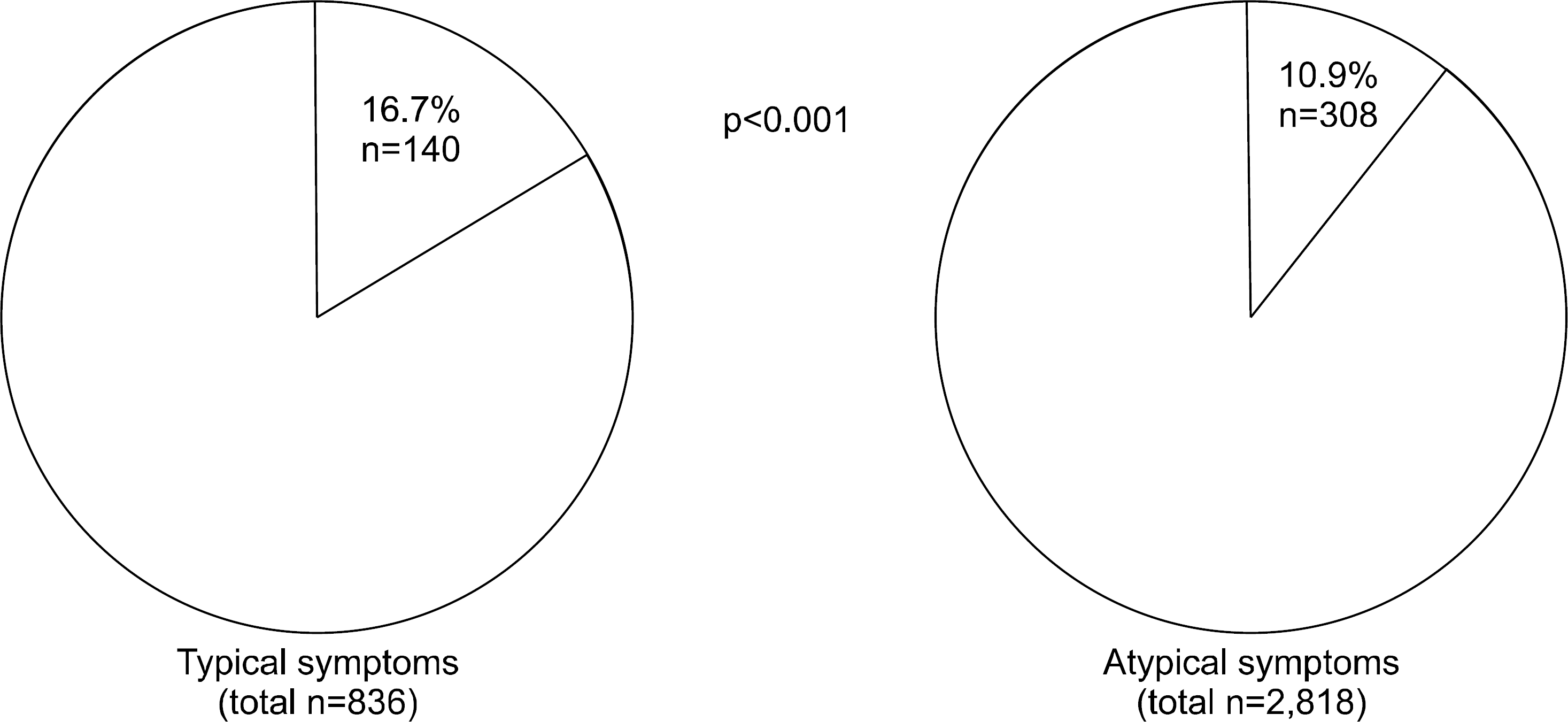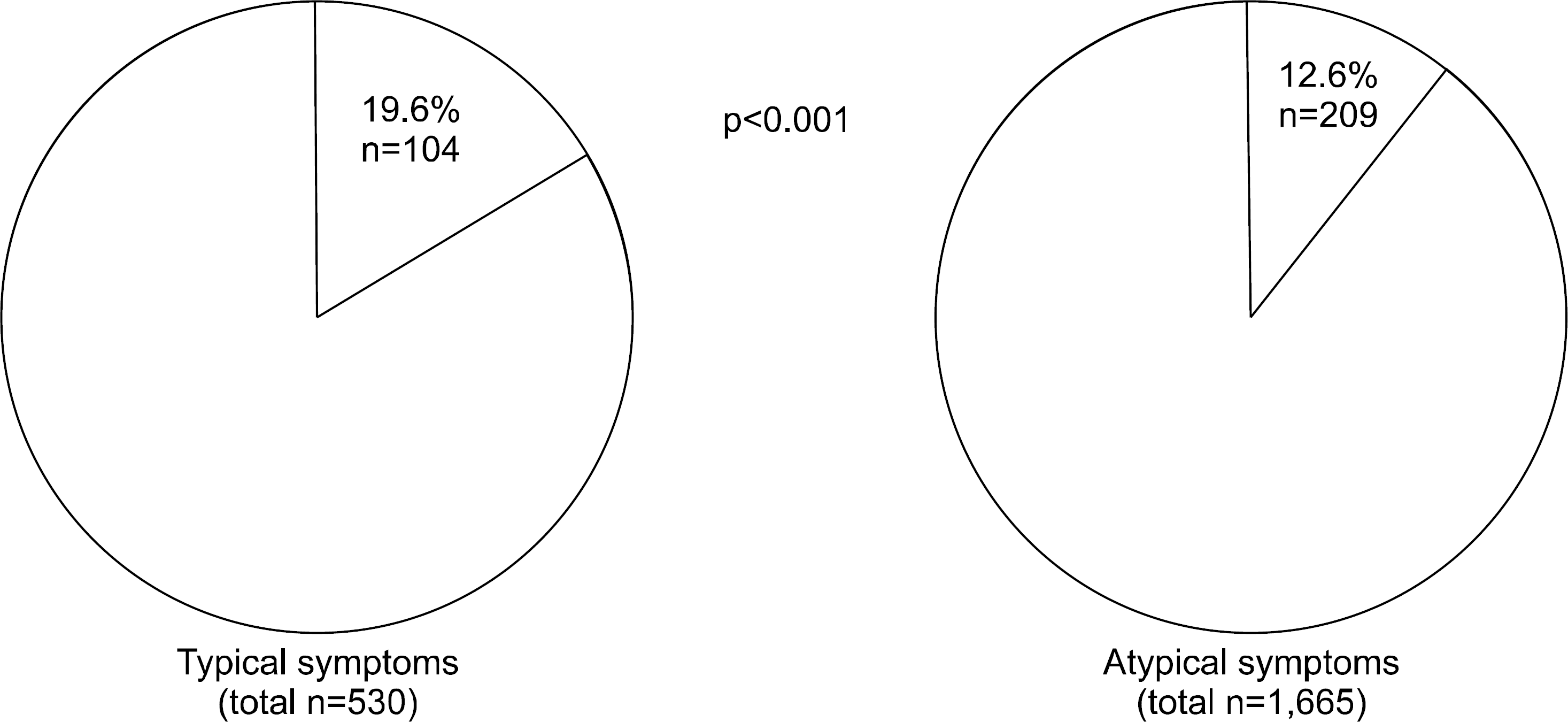Abstract
Background/Aims
Recent studies suggest that the prevalence of erosive esophagitis (EE) is increasing in Asia. The aims of this study were to determine the prevalence of EE among outpatients visiting gastroenterology clinics of secondary and tertiary hospitals in Korea, and to analyze their symptoms.
Methods
From May to July 2003, outpatients undergoing their first upper gastrointestinal endoscopies after visiting gastroenterology clinics in secondary and tertiary hospitals in Korea were enrolled. Prevalence of EE was calculated from their endoscopic findings, and symptoms were analyzed from the validated symptom questionnaire.
Results
Among 4,275 cases from 24 hospitals, 506 (11.8%) had EE. Among 836 cases with predominantly typical GERD symptoms, EE was diagnosed in 140 (16.7%). Among 530 cases having predominantly typical GERD symptoms with a frequency of at least twice a week or with a significant impact on their daily lives, EE was found in 104 (19.6%). The prevalence of EE was positively associated with males irrespective of age, old aged (≥65 years) females, predominantly typical GERD symptoms at least twice a week, and the numbers of typical GERD symptoms. The severity of GERD symptoms did not affect the prevalence of EE. The most common typical and atypical GERD symptoms in cases with EE were regurgitation and epigastric soreness, respectively.
Go to : 
REFERENCES
1. Fock KM, Talley NJ, Fass R, et al. Asia-Pacific consensus on the management of gastroesophageal reflux disease: update. J Gastroenterol Hepatol. 2008; 23:8–22.

2. Wiklund I. Review of the quality of life and burden of illness in gastroesophageal reflux disease. Dig Dis. 2004; 22:108–114.

3. Locke GR 3rd, Talley NJ, Fett SL, Zinsmeister AR, Melton LJ 3rd. Prevalence and clinical spectrum of gastroesophageal reflux: a population-based study in Olmsted County, Minne-sota. Gastroenterology. 1997; 112:1448–1456.

4. Cho YS, Choi MG, Jeong JJ, et al. Prevalence and clinical spectrum of gastroesophageal reflux: a population-based study in Asan-si, Korea. Am J Gastroenterol. 2005; 100:747–753.

5. Yang SY, Lee OY, Bak YT, et al. Prevalence of gastroesophageal reflux disease symptoms and uninvestigated dyspepsia in Korea: a population-based study. Dig Dis Sci. 2008; 53:188–193.

6. Jeon SG, Sohn CI, Kim JE, et al. Prevalence of gastroesophageal reflux in routine check-up subjects. Korean J Med. 2000; 58:145–151.
7. Oh JH, Choi MG, Kim HR, et al. Clinical spectrum of endoscopic reflux esophagitis in routine check-up subjects in Korea. Korean J Gastrointest Motil. 2006; 12:12–18.
8. Na IK, Jung JI, Pard HS. The prevalence and associated factors of reflux esophagitis in routine check-up subjects. J Korean Acad Fam Med. 2001; 22:1647–1655.
9. Yoo SS, Lee WH, Ha J, et al. The prevalence of esophageal disorders in the subjects examined for health screening. Korean J Gastroenterol. 2007; 50:306–312.
10. Kim N, Lee SW, Cho SI, et al. The prevalence of and risk factors for erosive oesophagitis and non-erosive reflux disease: a nationwide multicentre prospective study in Korea. Aliment Pharmacol Ther. 2008; 27:173–185.

11. Cho SH, Kim CW. The relationship between obesity and reflux esophagitis in health check-up subjects. Korean J Obes. 2007; 16:58–64.
12. Armstrong D, Bennett JR, Blum AL, et al. The endoscopic assessment of esophagitis: a progress report on observer agreement. Gastroenterology. 1996; 111:85–92.

13. Kim BC, Yoon YH, Jyung HS, et al. Clinical characteristics of gastroesophageal reflux diseases and association with Helicobacter pylori infection. Korean J Gastroenterol. 2006; 47:363–369.
14. Jeon SG, Rhee PL, Shin MH, et al. The prevalence and risk factors of reflux esophagitis in routine check-up subjects. Korean J Gastroenterol. 1998; 32:701–708.
15. Pilotto A, Franceschi M, Leandro G, et al. Clinical features of reflux esophagitis in older people: a study of 840 consec-utive patients. J Am Geriatr Soc. 2006; 54:1537–1542.

16. Castell DO. The esophagus. 2nd ed.Boston: Little Brown and Company;1995.
17. Amano K, Adachi K, Katsube T, Watanabe M, Kinoshita Y. Role of hiatus hernia and gastric mucosal atrophy in the development of reflux esophagitis in the elderly. J Gastroenterol Hepatol. 2001; 16:132–136.

18. Inamori M, Togawa J, Nagase H, et al. Clinical characteristics of Japanese reflux esophagitis patients as determined by Los Angeles classification. J Gastroenterol Hepatol. 2003; 18:172–176.

19. Furukawa N, Iwakiri R, Koyama T, et al. Proportion of reflux esophagitis in 6010 Japanese adults: prospective evaluation by endoscopy. J Gastroenterol. 1999; 34:441–444.

20. Okamoto K, Iwakiri R, Mori M, et al. Clinical symptoms in endoscopic reflux esophagitis: evaluation in 8031 adult subjects. Dig Dis Sci. 2003; 48:2237–2241.

21. Hung CS, Lee CL, Yang JN, et al. Clinical application of Carlsson's questionnaire to predict erosive GERD among healthy Chinese. J Gastroenterol Hepatol. 2005; 20:1900–1905.

22. Chen TS, Chang FY. The prevalence and risk factors of reflux esophagitis among adult Chinese population in Taiwan. J Clin Gastroenterol. 2007; 41:819–822.

23. Rosaida MS, Goh KL. Gastro-oesophageal reflux disease, reflux oesophagitis and non-erosive reflux disease in a multi-racial Asian population: a prospective, endoscopy based study. Eur J Gastroenterol Hepatol. 2004; 16:495–501.
24. Wong BCY, Kinoshita Y. Systematic review on epidemiology of gastroesophageal reflux disease in Asia. Clin Gastroenterol Hepatol. 2006; 4:398–407.

25. Kawanishi M. Will symptomatic gastroesophageal reflux disease develop into reflux esophagitis? J Gastroenterol. 2006; 41:440–443.

26. Labenz J, Nocon M, Lind T, et al. Prospective follow-up data from the ProGERD study suggest that GERD is not a catego-rial disease. Am J Gastroenterol. 2006; 101:2457–2462.

27. Faybush EM, Fass R. Gastroesophageal reflux disease in non-cardiac chest pain. Gastroenterol Clin North Am. 2004; 33:41–54.

28. Wong WM, Lai KC, Lau CP, et al. Upper gastrointestinal evaluation of Chinese patients with non-cardiac chest pain. Aliment Pharmacol Ther. 2002; 16:465–471.

29. Vakil N, van Zanten SV, Kahrilas P, Dent J, Jones R. The Montreal definition and classification of gastroesophageal reflux disease: a global evidence-based consensus. Am J Gastroenterol. 2006; 101:1900–1920.

30. Dent J, Armstrong D, Delaney B, Moayyedi P, Talley NJ, Vakil N. Symptom evaluation in reflux disease: workshop background, processes, terminology, recommendations, and discussion outputs. Gut. 2004; 53(Suppl 4):iv1–24.

31. Kim JH, Rhee PL, Park EH, Son HJ, Kim JJ, Rhee JC. Clinical usefulness of subgrouping of patients with non-cardiac chest pain according to characteristic symptoms in Korea. J Gastroenterol Hepatol. 2007; 22:320–325.

32. Galmiche JP. Endoscopy-negative reflux disease: part of the spectrum of gastro-oesophageal reflux disease or a separate disorder? Implications for treatment. Aliment Pharmacol Ther. 2005; 21(Suppl 1):9–10.
33. Smout AJ, Geus WP, Mulder PG, Stockbrugger RW, Lamers CB. Gastro-oesophageal reflux disease in The Netherlands. Results of a multicentre pH study. Scand J Gastroenterol Suppl. 1996; 31:10–15.

34. Lee JH, Lee JS, Rhee PL, et al. Interobserver variation in the endoscopic diagnosis of gastroesophageal reflux disease. Korean J Gastrointest Endosc. 2006; 33:197–203.
Go to : 
 | Fig. 1.Flow chart of enrolled patients.
∗ 47 cases had both gastric and duodenal ulcers and 4 cases had both gastric cancers and gastric or duodenal ulcers.
|
 | Fig. 2.Prevalence of erosive esophagitis according to the predominant symptoms. Erosive esophagitis was more frequently diagnosed in cases with predominantly typical gastroesophageal reflux disease symptoms than in those with atypical symptoms. |
 | Fig. 3.Prevalence of erosive esophagitis in cases with frequent or severe symptoms. Erosive esophagitis was more frequently diagnosed in cases with frequent (at least twice a week) or severe predominantly typical symptoms than in those with frequent or severe predominantly atypical symptoms. |
Table 1.
Ten Symptoms Listed in the Questionnaire
Table 2.
Age and Gender Distribution of the Study Subjects (n=4,275)
Table 3.
Prevalence of Erosive Esophagitis according to Gender (n=4,275)
| Erosive esophagitis | Total | Prevalence | p-value | ||
|---|---|---|---|---|---|
| Yes | No | ||||
| Male | 332 | 1,557 | 1,889 | 17.6% | <0.001 |
| Female | 174 | 2,212 | 2,386 | 7.3% | |
| Total | 506 | 3,769 | 4,275 | 11.8% | |
Table 4.
Prevalence of Erosive Esophagitis according to Age (n=4,275)
Table 5.
Prevalence of Erosive Esophagitis according to the Predominant Symptoms (n=3,654)
| Symptoms | Frequent (≥2x/week) or clinically significant symptoms∗ | Total∗ | ||
|---|---|---|---|---|
| Typical symptoms | 1. | 가슴이 따갑다 또는 쓰리다. | 32/235 (13.6%) | 45/345 (13.0%) |
| 2. | 가슴 가운데 부분에 타는 듯한 또는 뜨거운 듯한 불편감이나 통증이 있다. | 13/86 (15.1%) | 16/128 (12.5%) | |
| 3. | 목구멍이나 입으로 신 물 또는 쓴 물이 올라온다. | 59/209 (28.2%) | 79/363 (21.8%) | |
| Subtotal: | 104/530 (19.6%) | 140/836 (16.7%) | ||
| Atypical symptoms | 4. | 가슴이 아프다 또는 뻐근하다. | 34/229 (14.8%) | 49/388 (12.6%) |
| 5. | 음식을 삼킬 때 걸리거나 잘 내려가지않는다. | 15/137 (10.9%) | 22/177 (12.4%) | |
| 6. | 목에 뭔가 걸려 있는 또는 붙어 있는 것 같다. | 36/271 (13.3%) | 41/354 (11.6%) | |
| 7. | 목이 간질간질하거나 목소리를 맑게 하기 위해 헛기침을 한다. | 15/111 (13.5%) | 21/183 (11.5%) | |
| 8. | 목이 자주 쉬는 경향이 있다. | 1/37 (2.7%) | 3/64 (4.7%) | |
| 9. | 명치 아래에 고춧가루를 뿌려놓은 것처럼 화끈거린다. | 26/161 (16.1%) | 32/224 (14.3%) | |
| 10. | 명치에서 배꼽 사이가 쓰리거나 아프다. | 78/676 (11.5%) | 107/1,055 (10.1%) | |
| 11. | 기타 증상 | 4/43 (9.3%) | 33/373 (8.8%) | |
| Subtotal: | 209/1,665 (12.6%) | 308/2,818 (10.9%) | ||
| Total | 313/2,195 (14.3%) | 448/3,654 (12.3%) |
Table 6.
Predominant Symptoms in Patients with Erosive Esophagitis (n=448)
Table 7.
Factors Associated with Erosive Esophagitis (Univariate Analysis)
| Variables | Prevalence of reflux esophagitis (%)∗ | p-value | OR | 95% CI |
|---|---|---|---|---|
| Gender and age | ||||
| Females <65 years | 123/1859 (6.6%) | |||
| Females ≥65 years | 40/263 (15.2%)† | <0.001 | 2.53 | 1.73-3.71 |
| Males <65 years | 248/1,339 (18.5%)† | <0.001 | 3.21 | 2.55-4.03 |
| Males ≥65 years | 37/193 (19.2%)† | <0.001 | 3.35 | 2.24-5.01 |
| Number of typical GERD symptoms | ||||
| 0 | 148/1673 (8.8%) | |||
| ≥1 | 300/1981 (15.1%) | <0.001 | 1.84 | 1.49-2.27 |
| 1 | 163/1,251 (13.0%)‡ | <0.001 | 1.54 | 1.22-1.95 |
| 2 | 100/571 (17.5%)‡ | <0.001 | 2.19 | 1.66-2.88 |
| 3 | 37/159 (23.3%)‡ | <0.001 | 3.13 | 2.09-4.68 |
| Frequency of predominantly typical GERD symptoms | ||||
| <1/week | 18/186 (9.7%) | |||
| ≥1/week | 116/619 (18.7%) | 0.003 | 2.15 | 1.27-3.64 |
| 1/week | 19/136 (14.0%)§ | 0.289 | 1.52 | 0.76-3.00 |
| ≥2/week | 43/245 (17.6%)§ | 0.025 | 1.99 | 1.11-3.57 |
| Daily | 54/238 (22.7%)§ | <0.001 | 2.74 | 1.54-4.86 |
| Severity of predominantly typical GERD symptoms | ||||
| Mild | 23/170 (13.5%)∥ | |||
| Moderate | 65/398 (16.3%)∥ | 0.449 | 1.25 | 0.75-2.09 |
| Severe | 46/240 (19.2%)∥ | 0.142 | 1.52 | 0.88-2.61 |
Table 8.
Factors Associated with Erosive Esophagitis (Multi-variate Analysis)
| Variables | p-value | OR | 95% CI |
|---|---|---|---|
| Gender and old age | |||
| Females ≥65 years | <0.001 | 2.48 | 1.68-3.66 |
| Males <65 years | <0.001 | 3.44 | 2.73-4.35 |
| Males ≥65 years | <0.001 | 3.81 | 2.53-5.74 |
| Number of typical GERD symptoms∗ | |||
| 1 | <0.001 | 1.62 | 1.26-2.08 |
| 2 | <0.001 | 2.28 | 1.69-3.09 |
| 3 | <0.001 | 3.07 | 1.98-4.74 |
| Frequent predominantly typical GERD symptoms (≥2/week) | 0.021 | 1.39 | 1.05-1.84 |




 PDF
PDF ePub
ePub Citation
Citation Print
Print


 XML Download
XML Download